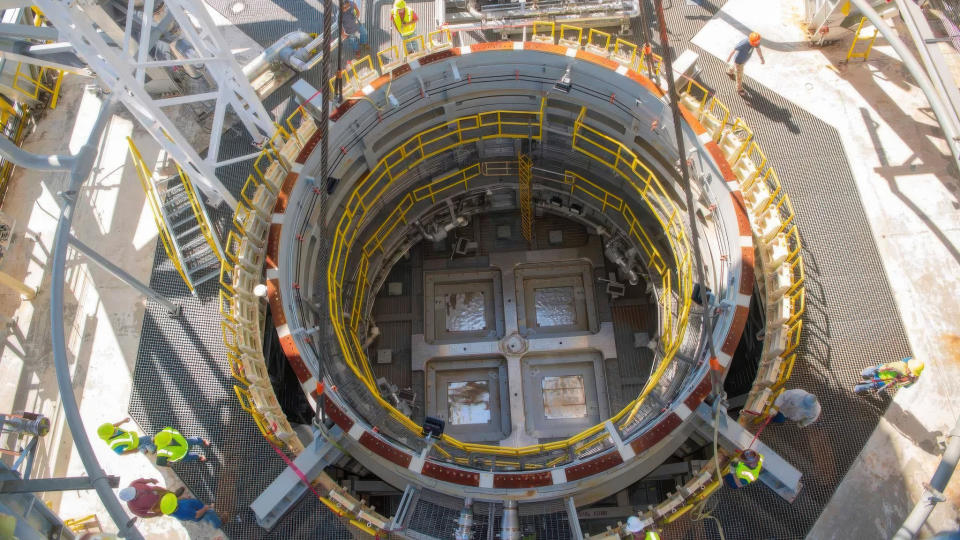NASA đã bỏ ra cả tháng 10 để nâng một phần mô phỏng nặng 103 tấn lên một cấu trúc thử nghiệm để chuẩn bị cho nhiệm vụ Mặt Trăng tiếp theo. NASA đã dành hai tuần qua để nâng một thành phần nặng 103 tấn lên một bộ mô phỏng và lắp ráp nó để chuẩn bị cho các nhiệm vụ tiếp theo tới Mặt Trăng. Phi hành đoàn đã lắp ráp bộ mô phỏng phân đoạn này lên Thad Cochran Test Stand tại Trung Tâm Vũ trụ Stennis gần Bay St. Louis, Mississippi. Phần kết nối này mô phỏng cùng một phần của hệ thống SLS (Hệ thống Phóng không gian) sẽ giúp bảo vệ tầng trên của tên lửa, giúp đẩy tàu vũ trụ Orion trong các nhiệm vụ Artemis đã lên kế hoạch. Thử nghiệm tại Trung tâm kiểm tra Thad Cochran là nơi NASA thiết lập các thành phần SLS và tiến hành kiểm tra cẩn thận để đảm bảo chúng sẽ an toàn và hoạt động đúng như ý định trên các phiên bản sẽ bay vào không gian. Phần mô phỏng mới được lắp ráp lên vị trí B-2 của trung tâm thử nghiệm và hiện đã được trang bị tất cả các ống dẫn, ống dẫn và hệ thống điện cần thiết cho các chạy thử tương lai.
#NASA #Artemis #Mặt Trăng #Thử nghiệm #SLS
NASA spent the last two weeks hoisting a 103-ton component onto a simulator and installing it to help prepare for the next Moon missions. Crews fitted the interstage simulator component onto the Thad Cochran Test Stand at Stennis Space Center near Bay St. Louis, Mississippi. The connecting section mimics the same SLS (Space Launch System) part that will help protect the rocket’s upper stage, which will propel the Orion spacecraft on its planned Artemis launches.
The Thad Cochran Test Stand is where NASA sets up the SLS components and conducts thorough testing to ensure they’ll be safe and operating as intended on the versions that fly into space. The new section was installed onto the B-2 position of the testing center and is now fitted with all the necessary piping, tubing and electrical systems for future test runs.

The interstage section will protect electrical and propulsion systems and support the SLS’s EUS (Exploration Upper Stage) in the rocket’s latest design iteration, Block 1B. It will replace the current Block 1 version and offer a 40 percent bigger payload. The EUS will support 38 tons of cargo with a crew or 42 tons without a crew, compared to 27 tons of crew and cargo in the Block 1 iteration. (Progress!) Four RL10 engines, made by contractor L3Harris, will power the new EUS.
The interstage simulator section NASA spent mid-October installing weighs 103 tons and measures 31 feet in diameter and 33 feet tall. The section’s top portion will absorb the EUS hot fire thrust, transferring it back to the test stand so the test stand doesn’t collapse under the four engines’ more than 97,000 pounds of thrust.
1 / 14
NASA’s testing at Stennis Space Center will prepare the SLS for the Artemis IV mission, which will send four astronauts aboard the Orion spacecraft to the Lunar Gateway space station to install a new module. After that, they’ll descend to the Moon’s surface in the Starship HLS (Human Landing System) lunar lander.
You can catch some glimpses into NASA’s heavy lifting in the video below:
[ad_2]

